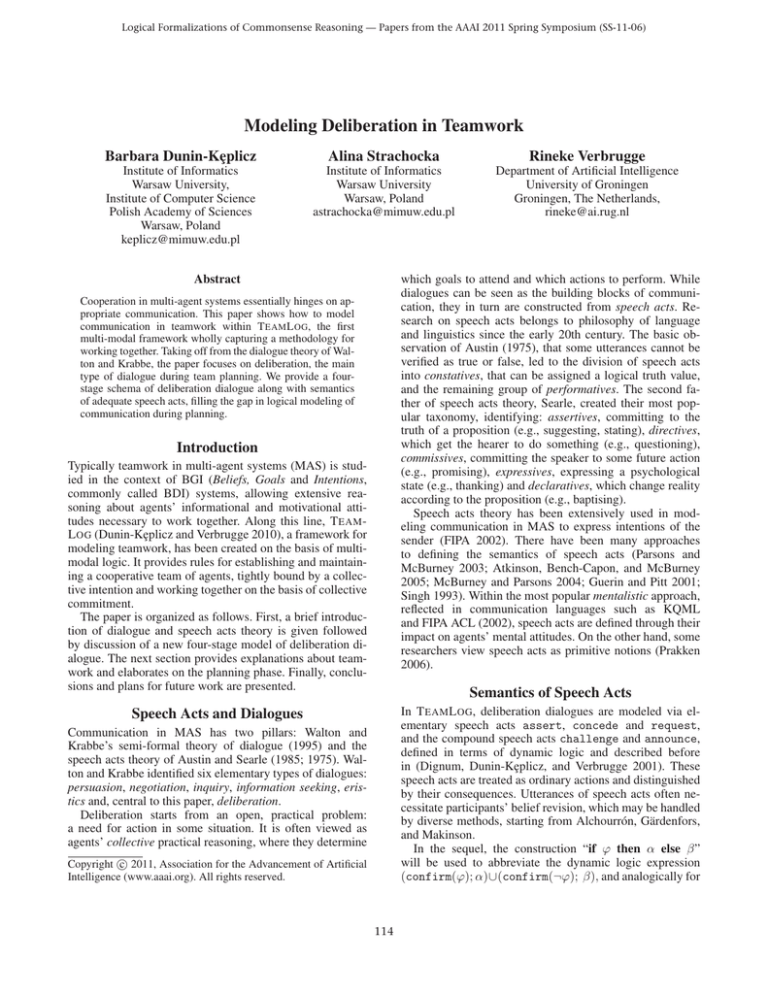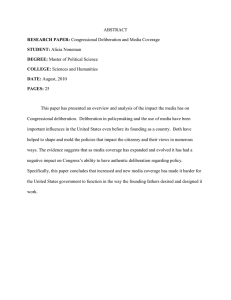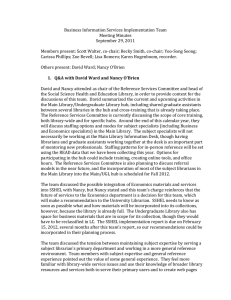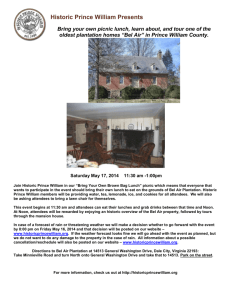
Logical Formalizations of Commonsense Reasoning — Papers from the AAAI 2011 Spring Symposium (SS-11-06)
Modeling Deliberation in Teamwork
Barbara Dunin-Kȩplicz
Alina Strachocka
Rineke Verbrugge
Institute of Informatics
Warsaw University,
Institute of Computer Science
Polish Academy of Sciences
Warsaw, Poland
keplicz@mimuw.edu.pl
Institute of Informatics
Warsaw University
Warsaw, Poland
astrachocka@mimuw.edu.pl
Department of Artificial Intelligence
University of Groningen
Groningen, The Netherlands,
rineke@ai.rug.nl
which goals to attend and which actions to perform. While
dialogues can be seen as the building blocks of communication, they in turn are constructed from speech acts. Research on speech acts belongs to philosophy of language
and linguistics since the early 20th century. The basic observation of Austin (1975), that some utterances cannot be
verified as true or false, led to the division of speech acts
into constatives, that can be assigned a logical truth value,
and the remaining group of performatives. The second father of speech acts theory, Searle, created their most popular taxonomy, identifying: assertives, committing to the
truth of a proposition (e.g., suggesting, stating), directives,
which get the hearer to do something (e.g., questioning),
commissives, committing the speaker to some future action
(e.g., promising), expressives, expressing a psychological
state (e.g., thanking) and declaratives, which change reality
according to the proposition (e.g., baptising).
Speech acts theory has been extensively used in modeling communication in MAS to express intentions of the
sender (FIPA 2002). There have been many approaches
to defining the semantics of speech acts (Parsons and
McBurney 2003; Atkinson, Bench-Capon, and McBurney
2005; McBurney and Parsons 2004; Guerin and Pitt 2001;
Singh 1993). Within the most popular mentalistic approach,
reflected in communication languages such as KQML
and FIPA ACL (2002), speech acts are defined through their
impact on agents’ mental attitudes. On the other hand, some
researchers view speech acts as primitive notions (Prakken
2006).
Abstract
Cooperation in multi-agent systems essentially hinges on appropriate communication. This paper shows how to model
communication in teamwork within T EAM L OG, the first
multi-modal framework wholly capturing a methodology for
working together. Taking off from the dialogue theory of Walton and Krabbe, the paper focuses on deliberation, the main
type of dialogue during team planning. We provide a fourstage schema of deliberation dialogue along with semantics
of adequate speech acts, filling the gap in logical modeling of
communication during planning.
Introduction
Typically teamwork in multi-agent systems (MAS) is studied in the context of BGI (Beliefs, Goals and Intentions,
commonly called BDI) systems, allowing extensive reasoning about agents’ informational and motivational attitudes necessary to work together. Along this line, T EAM L OG (Dunin-Kȩplicz and Verbrugge 2010), a framework for
modeling teamwork, has been created on the basis of multimodal logic. It provides rules for establishing and maintaining a cooperative team of agents, tightly bound by a collective intention and working together on the basis of collective
commitment.
The paper is organized as follows. First, a brief introduction of dialogue and speech acts theory is given followed
by discussion of a new four-stage model of deliberation dialogue. The next section provides explanations about teamwork and elaborates on the planning phase. Finally, conclusions and plans for future work are presented.
Semantics of Speech Acts
In T EAM L OG, deliberation dialogues are modeled via elementary speech acts assert, concede and request,
and the compound speech acts challenge and announce,
defined in terms of dynamic logic and described before
in (Dignum, Dunin-Kȩplicz, and Verbrugge 2001). These
speech acts are treated as ordinary actions and distinguished
by their consequences. Utterances of speech acts often necessitate participants’ belief revision, which may be handled
by diverse methods, starting from Alchourrón, Gärdenfors,
and Makinson.
In the sequel, the construction “if ϕ then α else β”
will be used to abbreviate the dynamic logic expression
(confirm(ϕ); α)∪(confirm(¬ϕ); β), and analogically for
Speech Acts and Dialogues
Communication in MAS has two pillars: Walton and
Krabbe’s semi-formal theory of dialogue (1995) and the
speech acts theory of Austin and Searle (1985; 1975). Walton and Krabbe identified six elementary types of dialogues:
persuasion, negotiation, inquiry, information seeking, eristics and, central to this paper, deliberation.
Deliberation starts from an open, practical problem:
a need for action in some situation. It is often viewed as
agents’ collective practical reasoning, where they determine
c 2011, Association for the Advancement of Artificial
Copyright Intelligence (www.aaai.org). All rights reserved.
114
“if ϕ then α”, where confirm(ϕ) refers to testing whether
ϕ holds (see (Dunin-Kȩplicz and Verbrugge 2010, Chapter
6)). [β]ϕ means that after performing β, ϕ holds.
BEL(i, ϕ)
C-BELG (ϕ)
[β](ϕ)
do-ac(i, α)
division(ϕ, σ)
means(σ, τ )
allocation(τ, P )
constitute(ϕ, P )
confirm(ϕ)
prefer(i, x, y)
Consequences of challenges. challengea,i (ϕ) stands
for a’s communicating its negative attitude towards ϕ to i.
The consequences of challenge are more complicated due
to the complexity of the speech act itself. It consists of a
negation of ϕ and of a request to prove ϕ:
agent i believes that ϕ
group G has the common belief that ϕ
after performing social action β, ϕ holds
agent i is just about to perform action α
σ is the sequence of subgoals resulting from
decomposition of ϕ
τ is the sequence of actions resulting from
means-end analysis on sequence σ
P is a social plan resulting from allocating
the actions from τ to team members
P is a correct social plan for achieving ϕ
plan to test if ϕ holds at the given world
agent i prefers x to y
Definition 3 If ϕ, P ROOF (ϕ) ∈ L, a, i ∈ A, then
CH challengea,i (ϕ) ≡ asserta,i (¬ϕ);
requesta,i (asserti,a (P ROOF (ϕ)))
The answer to the request in challenge should comply
with the rules for information seeking. If i is able to prove ϕ,
it should answer with asserti,a (P ROOF (ϕ)) being committed to P ROOF (ϕ). In return, a should refer to i’s previous answer. Thus1 , the consequences of challenge depend
on the outcome of the dialogue and can be twofold.
Definition 4 The consequences of challenges:
Table 1: Formulas and their intended meaning
CH1 [challengea,i (ϕ)] (BEL(a, ϕ) ∧ BEL(i, BEL(a, ϕ))
∧ BEL(a, P ROOF (ϕ)) ∧ BEL(i, BEL(a, P ROOF (ϕ))))
Consequences of assertions. asserta,i (ϕ) stands for
agent a telling agent i that ϕ holds.
CH2 [challengea,i (ϕ)] (¬BEL(i, ϕ) ∧ BEL(a, ¬BEL(i, ϕ))
∧¬BEL(i, P ROOF (ϕ))∧ BEL(a, ¬BEL(i, P ROOF (ϕ))))
Definition 1 The consequences of assertions:
In first case, [CH1], a admits it was wrong. The agents’
beliefs have changed, reflected by the acceptance of i’s
proof, which led to belief revision about ϕ. In the second
case, i admits it was wrong. Belief revision regarding
rejecting the proof of ϕ leads to updating beliefs about ϕ.
CA [asserta,i (ϕ)] (BEL(i, ϕ) ∧ BEL(i, BEL(a, ϕ)))
According to the fundamental assumption that agents
are as truthful as they can be, each assert(ϕ) obliges the
sender to believe in ϕ. The recipient has two possibilities to
react. Unless having beliefs conflicting with ϕ, it answers
with a concedei,a . Otherwise, with a challengei,a :
¬BEL(i, ¬ϕ) → do-ac(i, concedei,a (ϕ)),
BEL(i, ¬ϕ) → do-ac(i, challengei,a (ϕ)).
Consequences of announcements. An announcement
announcea,G (ϕ) can be seen as a complex assertion standing for “agent a announces to group G that ϕ holds”. In addition to informing about ϕ, the agent passes a message that
the same information has been delivered to the whole group.
The group becomes commonly aware that ϕ.
Consequences of requests. requesta,i (α) stands for agent
a requesting agent i to perform the action α. After a request
for information about ϕ (α = asserti,a (ϕ)), the sender
must wait for a reply. The receiver i has four options:
Definition 5 Consequences of announcements:
1. To ignore a and not answer at all.
CAN [announcea,G (ϕ)] C-BELG (ϕ).
2. To state that it is not willing to divulge this information.
3. To state that it does not have enough information about ϕ:
Four-stage Model of Deliberation
asserti,a (¬(BEL(i, ϕ) ∧ ¬BEL(i, ¬ϕ))).
The schema for deliberation dialogues presented below benefits from the model of McBurney, Hitchcock and Parsons (2007). It starts from a formal opening, introducing the
subject of the dialogue, aiming to make a common decision,
confirmed in a formal closure. Deliberation on “ψ(x)”2 aims
at finding the best t satisfying ψ from a finite candidate set
Tψ and to create a common belief about this among the team.
Even though deliberation during teamwork is a collective activity, its structure is imposed by the initiator a. Other agents
follow the rules presented below. Failure at any of the dialogue stages causes backtracking (compare with the reconfiguration algorithm (Dunin-Kȩplicz and Verbrugge 2010)).
4. Either to assert that ϕ is the case or that it is not:
BEL(i, ϕ) → do-ac(i, asserti,a (ϕ)), or
BEL(i, ¬ϕ) → do-ac(i, asserti,a (¬ϕ)).
The consequences are the same as for proper assertions.
Consequences of concessions. concedea,i (ϕ) stands for
agent a’s communicating its positive attitude towards ϕ to i.
Definition 2 The consequences of concessions:
CCO [concedea,i (ϕ)]BEL(i, BEL(a, ϕ)).
Concessions are similar to assertions. The only difference is
that i can assume that a believes ϕ in the course of dialogue,
but might retract it afterwards.
Assuming the rule BEL(a, P ROOF (ϕ)) → BEL(a, ϕ)
ψ is usually ungrounded, e.g. ψ(x) = president(x). The answers are (partially) grounded terms, e.g., president(JohnSmith).
1
2
115
Opening. Agent a’s first step is to open the deliberation
dialogue on the subject
ψ by a request to all other i ∈ G:
requesta,i ( if t∈Tψ ψ(t) then asserti,a (ψ(t))
else asserti,a (¬ t∈Tψ ψ(t))).
Agents have four ways of answering. If no one answers,
deliberation fails. Agent a waits for a certain amount of time
before concluding on the answers from group G.
Stages of Teamwork
Teamwork, as the pinnacle of cooperation, is essential in
multi-agent systems. The common division of teamwork
into four stages originates from (Wooldridge and Jennings
1999), while a complete model, binding these stages to formalized team attitudes, can be found in (Dunin-Kȩplicz and
Verbrugge 2010, Chapters 5 and 6). In summary:
1. Potential recognition. Teamwork begins when an initiator needs assistance and looks for potential groups of agents
willing to cooperate to achieve a certain common goal.
2. During team formation a loosely-coupled group of
agents is transformed into a strictly cooperative team sharing
a collective intention towards the goal.
3. During plan formation a team deliberates together how
to proceed, concluding in a collective commitment, based on
a social plan. Collective planning consists of three phases:
task division, leading to division(ϕ, σ), (σ is a sequence
of subgoals resulting from ϕ); means-end analysis, leading to means(σ, τ ) (τ is the sequence of actions resulting
from σ); and action allocation, leading to allocation(τ, P )
(P is a social plan resulting from allocating τ to agents).
Success of the sequence of three phases is summed up by
constitute(ϕ, P ) (P is a correct plan for achieving ϕ).
4. During team action agents execute their actions from the
plan. However, in real situations, many actions are at risk
of failure, calling for a necessary reconfiguration (DuninKȩplicz and Verbrugge 2010), describing agents’ behavior
to salvage their goal in terms of intelligent replanning.
With each stage of teamwork, adequate notions and complex definitions in T EAM L OG are connected. There is no
room for discussing them in detail, but see the book (DuninKȩplicz and Verbrugge 2010).
Voting. During voting, a announces to all i ∈ G its finite
set Tψ,a of all or preselected answers collected before:
asserta,i (
BEL(i, ψ(t)))
t∈Tψ,a i∈G
Next, agent a opens the voting by a request to all i ∈ G:
( if ψ(x) ∧ prefer(i, x, y) then
requesta,i (
x,y∈Tψ,a
asserti,a (prefer(i, x, y))))
Again, the agents have four answering possibilities. If no
one answers, the scenario leads back to step 1, which is
justified because the communication in step 2 may entail
some belief revisions. Should some answers be received, a
“counts the votes”, possibly using different evaluation functions, e.g., weighted by trust towards certain agents.
Confirming. Then, a announces the winning proposal w
and requests all opponents from G to start a persuasion:
(prefer(i, t, w))
requesta,i ( if BEL(i, ¬ψ(w)) ∨
t∈Tψ,a
then asserti,a (¬ψ(w) ∨ prefer(i, t, w)))
During this phase, if no agent steps out, the scenario moves
to the closure. If, on the other hand, there is an agent j who
thinks that w is not the best option, it has to announce this
and challenge a to provide a proof (using challenge). Thus
the dialogue switches to persuasion, where j must convince
a of the competing offer t, or that ψ(w) doesn’t hold. If it
succeeds, a adopts and heralds agent’s j thesis to all i ∈ G:
Unveiling the Plan Formation Stage
The (formal) aim of plan formation is transition from collective intention to collective commitment, achieved by means
of dialogue. Consider, as an example, a team of various
unmanned winter service vehicles: snow plow (SP ), snow
blower (SB), salt spreader (SS), 10 lightweight robots with
snow shovels (LRS1 ...LRS10 ), transporter truck (T T ), helicopter (H) and team leader (or initiator) with a goal to
remove the snow from the roof: ϕ = office SR. Suppose
that potential recognition and team formation have been successful. Then, the first phase of planning, task division, aims
at dividing the overall goal ϕ into a sequence of subgoals.
Leader opens the deliberation dialogue by requesting all
other i ∈ G to share their ideas:
asserta,i (¬ψ(w) ∨ prefer(a, t, z))
In this situation, the remaining agents may concede:
concedei,a (¬ψ(w) ∨ prefer(a, t, z))
or they may challenge the thesis:
challengei,a (¬ψ(w) ∨ prefer(a, t, z)).
If they choose to challenge, a must get involved into persuasion with the challenging agent. Finally, when all conflicts
have been resolved, the scenario moves to the final stage.
requestleader ,i ( if
division(office SR, σ)
σ∈TGoals
then assert(division(office SR, σ))
division(office SR, σ))),
else assert(¬
Closure. At last, a announces the final decision z:
announcea,G (ψ(z)).
α∈TGoals
where σ is a sequence of goals from a pre-given finite set of
goals TGoals . The leader waits a while before collecting the
answers from G. Suppose two agents decide to respond: SP
and H. SP proposes the sequence σSP :
Deliberating agents collaborate on the future course of actions, each of them trying to influence the final outcome.
The principal kind of reasoning here is goal-directed practical reasoning, leading to a plan. Let us place deliberation in
the context of teamwork.
σSP = send LRS roof, clean area, clean roof, return.
116
In other words, it proposes that first the LRS agents must be
delivered to the roof, after that the building’s surroundings
must be cleared of snow, next the roof must be cleaned, then
the team may return to the base. H proposes σH :
and complex actions. These can be further applied as building blocks of different dialogues types. The entire multimodal framework constituting T EAM L OG is presented in the
recent book (Dunin-Kȩplicz and Verbrugge 2010).
In its view, the only difference is the ordering of goals. As a
response to the leader’s call, the two agents utter:
Conclusions and Future Work
σH = send LRS roof, clean roof, clean area, return.
We have introduced a novel approach to modeling deliberation dialogues in teamwork. Although dialogues and speech
assertH ,leader (division(office SR, σH ))
acts have been frequently used to model communication in
multi-agent systems (FIPA 2002), the T EAM L OG solution is
The consequence of these two assertions is belief reunique. The proposed scenario consists of four stages, durvision. The second step is voting. Leader announces
ing which agents submit their proposals, vote on preferred
a pre-selected subset of answers collected in the preones and challenge or concede the choice of the selected
vious step. The pre-selected set of candidate terms is
one. If other types of dialogues, like persuasion, are to be
Toffice SR,leader = {σSP , σH }. Next comes disclosing this
embedded into deliberation, this is precisely stated in the
information to all other agents i ∈ G:
⎛
⎞ scenario, as opposed to (McBurney, Hitchcock, and Parsons
2007). The possibility to embed, for example, a negotiation
assertleader ,i ⎝
BEL(i, division(office SR, t))⎠ within a persuasion in the confirming stage of deliberation
t∈Toffice SR,leader i∈G
about action allocation, provides an appropriate amount of
flexibility, enabling smooth teamwork (about the importance
Subsequently, leader opens voting on proposals by reof dialogue embedding, see also (Dunin-Kȩplicz and Verquests to all i ∈ G:
brugge 2003)). Different types of dialogues are strictly distinguished, and the boundary between them is clearly out
requestleader ,i (
( if BEL(i, division(office SR, x)) lined. In the course of deliberation, a social plan leading to
x,y∈Toffice SR,leader
the overall goal is created, belief revision is done and growth
of knowledge can be observed. Finally, along with existing
∧ prefer(i, x, y) then asserti,leader (prefer(i, x, y))))
schemas for persuasion and information seeking (Dignum,
In step 3, confirming, leader announces that for example
Dunin-Kȩplicz, and Verbrugge 2001), the most vital aspects
σSP won and calls potential opponents to start a persuasion
of communication in T EAM L OG are now addressed.
dialogue, by sending a request to all other i ∈ G:
In future, communication in the presence of uncertain and
possibly inconsistent information will be investigated, most
requestleader ,i ( if BEL(i, ¬division(office SR, σSP ))∨
probably requiring a new model of T EAM L OG.
assertSP,leader (division(office SR, σSP )) and
t∈Toffice SR prefer(i, t, σSP ) then
asserti,leader (¬division(office SR, σSP )∨prefer(i, t, σSP )))
Acknowledgements
If agent H prefers its own proposal, it raises an objection:
assertH ,leader (prefer(i, σH , σSP ))
This is followed by leader’s challenge to provide a proof.
At this point, the dialogue switches to persuasion, which has
been discussed in (Dignum, Dunin-Kȩplicz, and Verbrugge
2001; Dunin-Kȩplicz and Verbrugge 2010). Step 4 (closure)
follows the same pattern, leading, if successful, to a subgoal
sequence σ such that division(office SR, σ) holds.
The next step is means-end-analysis, when every subgoal must be assigned a (complex) action realizing it. If
the whole process concerning all subgoals from σ succeeds, there is an action sequence τ such that means(σ, τ )
holds. The final step is action allocation, resulting, if successful, in a plan P for which allocation(τ, P ) holds. Finally, constitute(office SR, P ) is reached and planning terminates. There is now a basis to establish a collective commitment and to start working.
Although deliberation in the course of teamwork is a complex process, all its phases can be naturally specified in
T EAM L OG. First, the central notions in a theory of teamwork, collective group attitudes, are defined in terms of other
informational and motivational attitudes (via fixpoint definitions). Then, the dynamic component of T EAM L OG allows
one to specify consequences of various speech acts, plans,
This research has been supported by the Polish grant
N N206 399334 and Dutch Vici grant NWO-277-80-001.
References
Alchourrón, C. E.; Gärdenfors, P.; and Makinson, D. 1985.
On the logic of theory change: Partial meet contraction and
revision functions. Journal of Symbolic Logic 50(2):510–
530.
Atkinson, K.; Bench-Capon, T.; and McBurney, P. 2005.
Computational representation of practical argument. Synthese 152:157–206.
Austin, J. L. 1975. How to Do Things with Words. Oxford:
Clarendon Press, second edition. Edited by J. O. Urmson
and M. Sbisa.
Dignum, F.; Dunin-Kȩplicz, B.; and Verbrugge, R. 2001.
Creating collective intention through dialogue. Logic Journal of the IGPL 9:145–158.
Dunin-Kȩplicz, B., and Verbrugge, R. 2010. Teamwork in
Multi-Agent Systems: A Formal Approach. Chichester: Wiley.
Dunin-Kȩplicz, B., and Verbrugge, R. 2003. Dialogue in
teamwork. In Proceedings of the 10th ISPE International
117
Parsons, S., and McBurney, P. 2003. Argumentation-based
dialogues for agent coordination. Group Decision and Negotiation 12:415–439.
Prakken, H. 2006. Formal systems for persuasion dialogue.
The Knowledge Engineering Review 21(2):163–188.
Searle, J., and Vanderveken, D. 1985. Foundations of Illocutionary Logic. Cambridge: Cambridge University Press.
Singh, M. 1993. A semantics for speech acts. Annals of
Mathematics and Artificial Intelligence 8:47–71.
Walton, D., and Krabbe, E. 1995. Commitment in Dialogue:
Basic Concepts of Interpersonal Reasoning. Albany (NY):
State University of New York Press.
Wooldridge, M., and Jennings, N. 1999. The cooperative
problem-solving process. Journal of Logic and Computation
9(4):563–592.
Conference on Concurrent Engineering: Research and Applications, 121–128. Rotterdam: A.A. Balkema.
FIPA. 2002. http://www.fipa.org/.
Guerin, F., and Pitt, J. 2001. Denotational semantics for
agent communication language. In AGENTS ’01: Proceedings of the Fifth International Conference on Autonomous
Agents, 497–504. New York, NY, USA: ACM.
McBurney, P., and Parsons, S. 2004. A denotational semantics for deliberation dialogues. In AAMAS ’04: Proceedings
of the Third International Joint Conference on Autonomous
Agents and Multiagent Systems, 86–93. Washington, DC,
USA: IEEE Computer Society.
McBurney, P.; Hitchcock, D.; and Parsons, S. 2007. The
eightfold way of deliberation dialogue. International Journal of Intelligent Systems 22(1):95–132.
118



